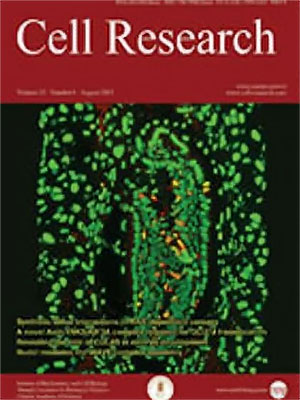
Volume 14, No 4, Aug 2004
ISSN: 1001-0602
EISSN: 1748-7838 2018
impact factor 17.848*
(Clarivate Analytics, 2019)
Volume 14 Issue 4, August 2004: 324-330
ORIGINAL ARTICLES
Characterization of Function of Three Domains in Dishevelled-1: DEP Domain is Responsible for Membrane Translocation of Dishevelled-1
Wei Jun PAN1*, Shu Zhao PANG1,2*, Tao HUANG1, Hui Yun GUO2, Dianqing WU3, Lin LI1**
1Laboratory of Molecular Cell Biology, Institute of Biochemistry and Cell Biology, Shanghai Institutes for Biological Sciences, Chinese Academy of Sciences, Graduate School of the Chinese Academy of Sciences, 320 Yueyang Rd, Shanghai 200031;
2College of Life Science, Jilin University, Changchun 130061, China.
3Department of Genetics and Developmental Biology, University of Connecticut Health Center, Farmington, Connecticut 06030, USA.
Correspondence: Lin Li(lli@sibs.ac.cn)
Wnt signaling plays an important role in embryogenesis and tumorgenesis. Although the mechanism about how Wnts transduce their signaling from receptor frizzled (Fz) to cytosol has not been understood, dishevelled (Dvl) protein was considered as the intersection of Wnt signal traffic. In this study, we characterized the function of three domains (DIX, PDZ and DEP) of Dvl-1 in canonical Wnt signal transduction and Dvl-1 membrane translocation. It was found both DIX and DEP domain were sufficient to block Wnt-3a-induced LEF-1 transcriptional activity and free cytosol β-catenin accumulation; whereas PDZ domain and a functional mutant form of DEP domain (DEP-KM) had no effect on canonical Wnt signaling. In addition, when cotransfected with Fz-7, DEP domain, but not DIX, PDZ or DEP-KM, translocated and co-localized with Fz-7 to the plasma membrane, which was similar to Dvl-1. Furthermore, it was DEP domain that could block Fz-7-induced membrane translocation of Dvl-1 via a possible competitive mechanism. These results strongly suggest that DEP domain is responsible for the membrane translocation of Dvl-1 protein upon Wnt signal stimulation.
FULL TEXT | PDF
Browse 1931


